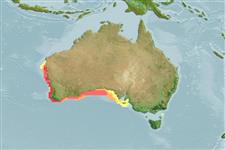Common names from other countries
Lớp phụ Cá sụn (cá mập và cá đuối) (sharks and rays) >
Orectolobiformes (Carpet sharks) >
Orectolobidae (Carpet or nurse sharks)
Etymology: Orectolobus: orektos (Gr.), stretched out; lobus (L.), from lobos (Gr.), rounded projection or protuberance, referring to long nasal barbels of Squalus barbatus (=O. maculatus). (See ETYFish); hutchinsi: In honor of J. Barry Hutchins (b. 1946), Curator of Fishes, Western Australian Museum (Perth), who first reported this shark as a new species in 1983. (See ETYFish).
More on authors: Last, Chidlow & Compagno.
Environment: milieu / climate zone / depth range / distribution range
Sinh thái học
Biển gần đáy; Mức độ sâu 0 - 106 m (Ref. 58024), usually 0 - 79 m (Ref. 58024). Tropical
Eastern Indian Ocean: Western Australia. Sympatric with O. maculatus and O. ornatus.
Bộ gần gũi / Khối lượng (Trọng lượng) / Age
Maturity: Lm ? range ? - ? cm
Max length : 149 cm TL con đực/không giới tính; (Ref. 58024)
Short description
Khóa để định loại | Hình thái học | Sinh trắc học
Diagnosis: A moderate-sized species with the following characters: yellowish-brown when fresh with well-defined, darker brown saddles; absence fo white spots, blotches or reticulations on the fins and body; nasal barbel bilobed; postspiracular lobes are simple, reduced or rudimentary; distance across preorbital lobe group 1.2-1.3 times interspace between preorbital group and postspiracular lobe, 13-15 times base length of anterior postspiracular lobe; base of anterior postspiracular lobe 11-12 in its distance from postorbital group, 4.9-7 in its distance from posterior postspiracular lobe; mouth width 4.7-10.2 times preoral distance; warty tubercles absent on back of adult; juveniles with rows of elevated denticles or poorly defined warty tubercles on back; dorsal fins raked posteriorly; first dorsal fin over rear half of pelvic -fin bases; interdorsal space 0.38-0.56 times anal-fin base length; anal-fin inner margin 0.8-1.1 times anal-fin posterior margin; teeth in upper jaw 25-27, those in the medial row at symphysis rudimentary; spiral valve turns 26-28; monospondylous centra 48-50 (Ref. 58024).
Males mature at about 111 cm TL. Young born at 22-26 cm TL (mean 24.1 cm TL based on 40 specimens). Caught as by-catch of local gillnet, longline, rock lobster and recreational fisheries (Ref. 58024).
Life cycle and mating behavior
Maturities | Sự tái sinh sản | Spawnings | Egg(s) | Fecundities | Ấu trùng
Last, P.R., J.A. Chidlow and L.J.V. Compagno, 2006. A new wobbegong shark, Orectolobus hutchinsi n. sp. (Orectolobiformes: Orectolobidae) from southwestern Australia. Zootaxa 1239:35-48. (Ref. 58024)
IUCN Red List Status (Ref. 130435)
CITES (Ref. 128078)
Not Evaluated
Threat to humans
Harmless
Human uses
Các công cụ
Special reports
Download XML
Các nguồn internet
Estimates based on models
Preferred temperature (Ref.
115969): 17.4 - 22.3, mean 18.3 (based on 126 cells).
Phylogenetic diversity index (Ref.
82804): PD
50 = 0.5012 [Uniqueness, from 0.5 = low to 2.0 = high].
Bayesian length-weight: a=0.00389 (0.00180 - 0.00842), b=3.12 (2.94 - 3.30), in cm Total Length, based on all LWR estimates for this body shape (Ref.
93245).
Mức dinh dưỡng (Ref.
69278): 4.0 ±0.6 se; based on size and trophs of closest relatives
Fishing Vulnerability (Ref.
59153): Very high vulnerability (89 of 100).
